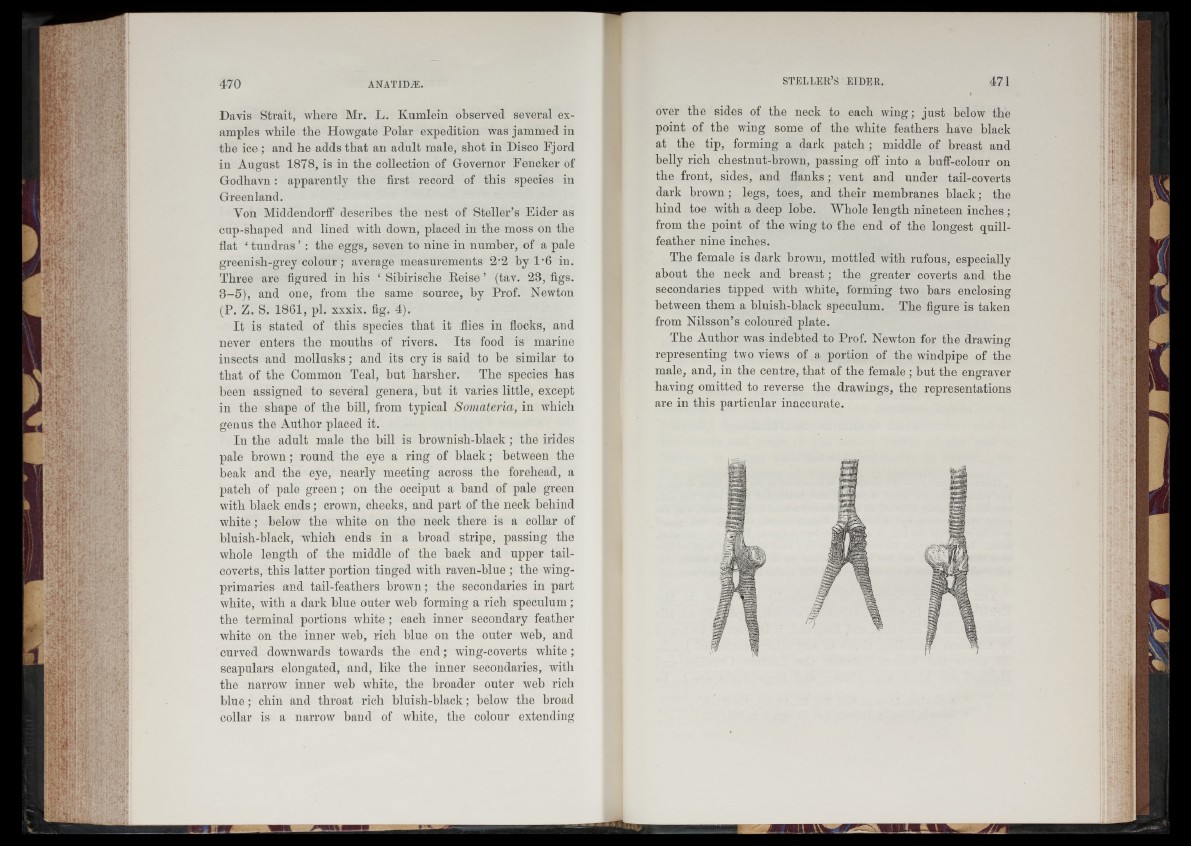
Davis Strait, where Mr. L. Kumlein observed several examples
while the Howgate Polar expedition was jammed in
the ice ; and he adds that an adult male, shot in Disco Fjord
in August 1878, is in the collection of Governor Fencker of
Godhavn: apparently the first record of this species in
Greenland.
Yon Middendorff describes the nest of Steller’s Eider as
cup-shaped and lined with down, placed in the moss on the
flat ‘ tundras ’ : the eggs, seven to nine in number, of a pale
greenish-grey colour ; average measurements 2‘2 by 1*6 in.
Three are figured in his ‘ Sibirische Keise ’ (tav. 23, figs.
3-5), and one, from the same source, by Prof. Newton
(P. Z. S. 1861, pi. xxxix. fig. 4).
It is stated of this species that it flies in flocks, and
never enters the mouths of rivers. Its food is marine
insects and mollusks; and its cry is said to be similar to
that of the Common Teal, but harsher. The species has
been assigned to several genera, but it varies little, except
in the shape of the bill, from typical Somateria, in which
genus the Author placed it.
In the adult male the bill is brownish-black; the irides
pale brown; round the eye a ring of black; between the
beak and the eye, nearly meeting across the forehead, a
patch of pale green ; on the occiput a band of pale green
with black ends; crown, cheeks, and part of the neck behind
white; below the white on the neck there is a collar of
bluish-black, which ends in a broad stripe, passing the
whole length of the middle of the back and upper tail-
coverts, this latter portion tinged with raven-blue ; the wing-
primaries and tail-feathers brown; the secondaries in part
white, with a dark blue outer web forming a rich speculum;
the terminal portions white ; each inner secondary feather
white on the inner web, rich blue on the outer web, and
curved downwards towards the end; wing-coverts white;
scapulars elongated, and, like the inner secondaries, with
the narrow inner web white, the broader outer web rich
blue ; chin and throat rich bluish-black; below the broad
collar is a narrow band of white, the colour extending
over the sides of the neck to each wing; just below the
point of the wing some of the white feathers have black
at the tip, forming a dark patch ; middle of breast and
belly rich chestnut-brown, passing off into a buff-colour on
the front, sides, and flanks; vent and under tail-coverts
dark brown ; legs, toes, and their membranes black; the
hind toe with a deep lobe. Whole length nineteen inches ;
from the point of the wing to the end of the longest quill-
featlier nine inches.
The female is dark brown, mottled with rufous, especially
about the neck and breast; the greater coverts and the
secondaries tipped with white, forming two bars enclosing
between them a bluish-black speculum. The figure is taken
from Nilsson’s coloured plate.
The Author was indebted to Prof. Newton for the drawing
representing two views of a portion of the windpipe of the
male, and, in the centre, that of the female ; but the engraver
having omitted to reverse the drawings, the representations
are in this particular inaccurate.